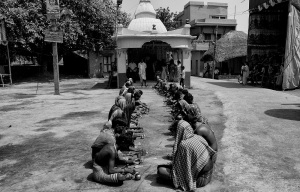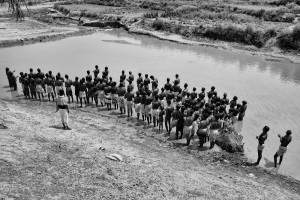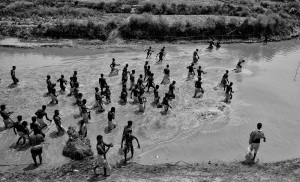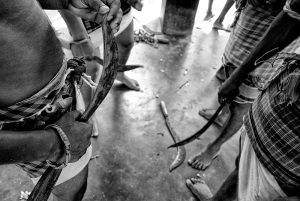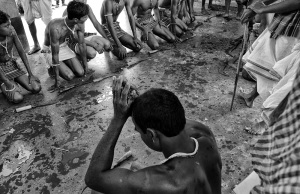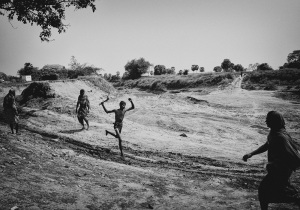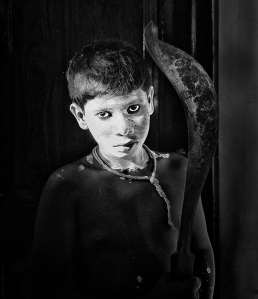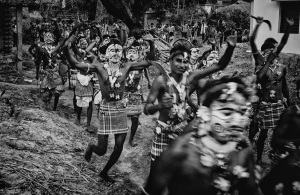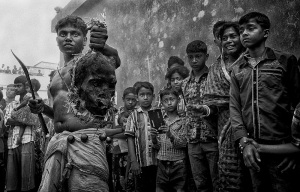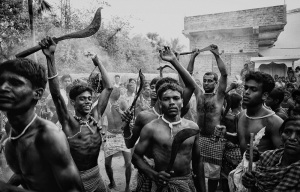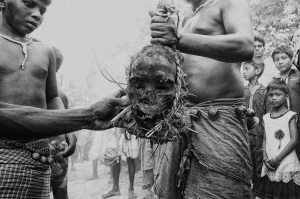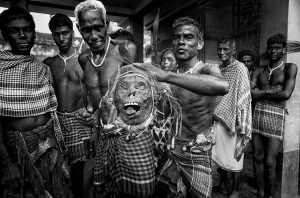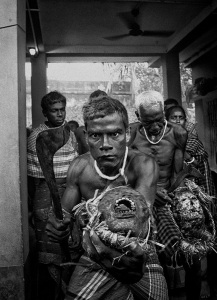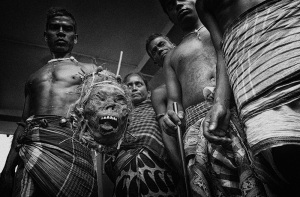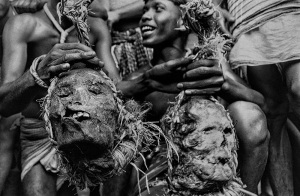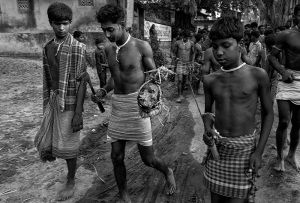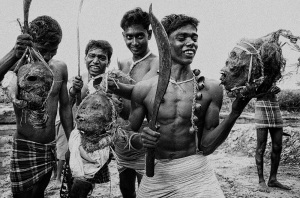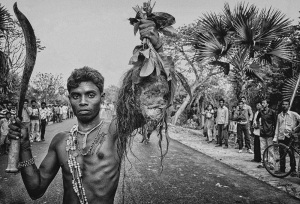Author Archives: avishekdasphotography
Illegal Sand Mining & Challenge on Bio Diversity
Illegal Sand Mining & Trading – Daily Life Story & Impact on Environment
Category: News / Documentary
Booming in Construction industries made a huge demand of Sand now a days, as a result Illegal Sand Mining is getting higher on daily basis. I have visited different parts of West Bengal to cover the activities how Sand is being mined without permission and under safe guard of local Mafias.
While interacting with the daily labor’s I came to know that they are being paid Rs. 200/- boat of Sand mined from the river for loading in Trucks. Daily in the side of different river banks minimum 50 – 60 families (Included Man, Woman & Child) are involved in these profession to full fill the boat with Sand. A labor is earning average 800 – 1000 Rupees /day while he is delivering 4 – 5 boat full of Sands. It is estimated to be a Rs 2 crore a day business altogether from the State.
The local suppliers & contractors are usually giving 3000 – 5000 Rupees /- Truck of Sand. Cost of per Truck depends on the quality of the Sand. For this illegal practice, different environmental issues are arising and mainly it is destroying Biological Diversity of Nature. Though Court has banned the activities, still under different parts of Bengal the process of Mining (Manually by Labor & by Machine) is running in a full swing where many local people are involved under the umbrella of the Local Leaders / Mafias.
Report & Images by: Avishek Das, West Bengal, India
Avishek Das Photography
2015
Crucification – A Painful Devotion
Gajan is a Hindu festival celebrated mostly in the Rural part of West Bengal. Gajan spans around a week, starting at the last week of Chaitra continuing till the end of the Bengali year.
The word Gajan is considered a combination of parts of two words – “Ga” is from the word gram meaning village and “jan” is from the word janasadharan meaning folk. In this sense Gajan is a festival of village folk. Some of the myth said Gajan means Gar+Jan = A Bengali Word which reveals the call of the sannyasi or Bhakta to their lord Shiva.Often in this festival Sannyasi or Bhakta are murmuring with the name of Lord Shiva on daily basis 108 times & together they cry with pain : Debadi Dev Mahadev .. Hara Gauri .. Joy Shiv . They often believe its such a powerful chant that keep them cool and help to overcome all the pain related to their painful process of devotion.
Hindus celebrate the festival mainly on the last two days of the month of Chaitra. This period is known as Chaitra Sankranti when Sun will enter Pisces sign. Chaitra Sankranti begins on 14th March of every year. People observe fast during this period devoting themselves to their God. Gajan is actually linked to persons who are related to agricultural community, directly or indirectly. They pray for the rains and better harvest. Lord Shiva is said to be closely related to this community.
This photo story is from a remote village in the district Hooghly, westBengal, India. Gajan is celebrated here more than 100 years. Devotees make one month restricted life as a part of the process like sleep on the floor,veg diet single time a day and known as SANYASI (devotee).
On the day of Gajan devotee gather in the oldest temple of LORD SHIVA in the village at night. At 12 o clock night, they made an holy bath in the river Ganga. After returning from bath they start their worship to LORD SHIVA, but the no of devotees is more than 50+, so it is not possible to accommodate all of them inside of the temple, so they worship their LORD SHIVA from outside the temple. It takes near about 3 to 4 hour, so when they complete their worship then it is dawn, and the day of the GAJAN starts. In the morning, the first event was “BANPHORE”, that is a 5mm iron rod penetrated through the devotee’s toung. The devotee bite the middle of the rod which penetrated through his toung. In this condition, all the devotees take part in a procession with the drum and other musical instrument and make aaround the village.
The second phase of programme is started at 8.30 am. Here the devotee’s activities are different. Cross made of wooden structure taken from the nearest pond and devotees being crucified with nail hammer with the structures. Water given continuously on their faces so that they can overcome the pain of crucification and blood can be stopped from their Body.
Next phase They are laying down on the nail bed, in this condition they make round in the village and the programme is end at 12.00 pm. It ends with Charak Puja Participants of this festival is known as Sannyasi or Devotee. Persons of any gender can be a participant. The complete history of the festival is not known. The central theme of this festival is deriving satisfaction through non-sexual pain, devotion and sacrifice.




















The Faith of Life (Documentry Photo Project)
Project : The Faith of Life
(Gajan Festival , West Bengal | India)
Gajan is a Hindu festival celebrated mostly in the Rural part of West Bengal. Gajan spans around a week, starting at the last week of Chaitra continuing till the end of the Bengali year. It ends with Charak Puja Participants of this festival is known as Sannyasi or Devotee .Persons of any gender can be a participant. The complete history of the festival is not known. The central theme of this festival is deriving satisfaction through non-sexual pain, devotion and sacrifice. The word Gajan is considered a combination of parts of two words – Ga is from the word gram meaning village and jan is from the word janasadharan meaning folk. In this sense Gajan is a festival of village folk .Some of the myth said Gajan means Gar+Jan = A Bengali Word which reveals the call of the sannyasi or Bhokta to their lord Shiva . Ofthen in this festival Sannyasi or Bhokta are murmuring with the name of Lord Shiva on daily basis 108 times & together they cry with pain : Debadi Dev Mahadev .. Hara Gauri .. Joy Shiv . They often believe its such a powerful chants that keep them cool and help to overcome all the pain related to their painful process of devotion.
Hindus celebrate the festival mainly on the last two days of the month of Chaitra. This period is known as Chaitra Sankranti when Sun will enter Pisces sign. Chaitra Sankranti begins on 14th March of every year. People observe fast during this period devoting themselves to their God. Gajan is actually linked to persons who are related to agricultural community, directly or indirectly. They pray for the rains and better harvest. Lord Shiva is said to be closely related to this community. It may be worth noting here that Dharmathakur is actually considered to be the God of Fertility.
Charak & Gajan has 2 separate part of Festival according to the Rituals . Gajan used to happen on 2 days before the Month end of Chaitra , the Last Bengali Month ( Middle of March as per English Calendar) . In different part of West Bengal these Rituals are being celebrated with different dangerous Traditional Play like Playing with Dead Bodies , Human Skull . This year we went to a Remote village of Bardhaman to observe this dangerous Practice . According to villagers, this practice has been going on for more than a hundred years. Police and district administration do very little to stop the ugly and unhygienic practices .According to one of the Devotees, they collect the bodies from different burial grounds. Those who could not burn the dead bodies due to financial reasons, bury those bodies in the graveyard. Sometimes the relatives of dead children do not burn the bodies and bury them instead.Some of the villages are using these skulls for 2 – 3 years and some of the village use to cut the skulls before 1 – 2 month of this Ritual from different graveyard. These skulls are used to hide in some secret places near by of the villages , people were co-operative enough to shoot us these dangerous photos but they stopped us to enter those secret places where they have hidden these skulls or dead bodies .
Observing this Dangerous Ritual may create Visual disturbance but this Ritual still live for 100 more years in rural part of Bengal , India.
** Attached Photos are in Serial wise as per Event.
Travel Potrait
The Snow Valley
Vintage Kolkata
Kolkata /koʊlˈkɑːtɑː/ (Bengali: কলকাতা), known historically in English as Calcutta /kælˈkʌtə/, is the capital of the Indian state ofWest Bengal. Located on the east bank of the Hooghly river, it is the principal commercial, cultural, and educational centre of East India, while the Port of Kolkata is India’s oldest operating port as well as its sole major riverine port. As of 2011, the city had 4.5 million residents; the urban agglomeration, which comprises the city and its suburbs, was home to approximately 14.1 million, making it the third-most populous metropolitan area in India. As of 2008, its economic output as measured by gross domestic product ranked third among South Asian cities, behind Mumbai and Delhi.[6] As a growing metropolitan city in a developing country, Kolkata confronts substantial urban pollution, traffic congestion, poverty, overpopulation, and other logistic and socioeconomic problems.
In the late 17th century, the three villages that predated Kolkata were ruled by the Nawab of Bengal under Mughal suzerainty. After the Nawab granted the East India Company a trading license in 1690,[7] the area was developed by the Company into an increasingly fortified mercantile base. Nawab Siraj ud-Daulah occupied Kolkata in 1756, and the East India Company retook it in the following year and by 1772 assumed full sovereignty. Under East India Company and later under the British Raj, Kolkata served as the capital of India until 1911, when its perceived geographical disadvantages, combined with growing nationalism inBengal, led to a shift of the capital to New Delhi. The city was the centre of the Indian independence movement; it remains a hotbed of contemporary state politics. Following Indian independence in 1947, Kolkata—which was once the centre of modern Indian education, science, culture, and politics—witnessed several decades of relative economic stagnation. Since the early 2000s, an economic rejuvenation has led to accelerated growth.
As a nucleus of the 19th- and early 20th-century Bengal Renaissance and a religiously and ethnically diverse centre of culture in Bengal and India, Kolkata has established local traditions in drama, art, film, theatre, and literature that have gained wide audiences. Many people from Kolkata—among them several Nobel laureates—have contributed to the arts, the sciences, and other areas, while Kolkata culture features idiosyncrasies that include distinctively close-knit neighbourhoods (paras) and freestyle intellectual exchanges (adda). West Bengal’s share of the Bengali film industry is based in the city, which also hosts venerable cultural institutions of national importance, such as the Academy of Fine Arts, the Victoria Memorial, the Asiatic Society, the Indian Museum, and the National Library of India. Though home to major cricketing venues and franchises, Kolkata differs from other Indian cities by giving importance to association football and other sports.
Summer Break

Young Guys are jumping to Sea for breaking their Summer Thirst
Lines & Shadow

Line & Shadow from the concept of street Photography.
The invisible




































